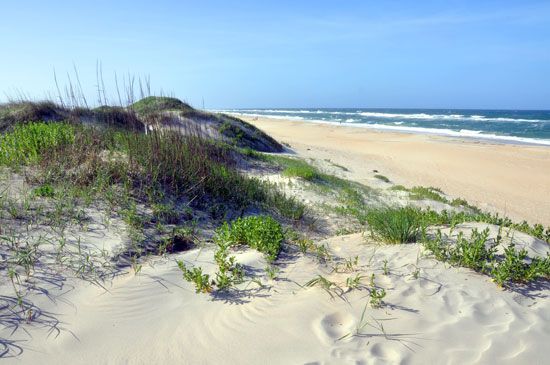Outer Banks
Our editors will review what you’ve submitted and determine whether to revise the article.
- Also called:
- the Banks
Outer Banks, chain of barrier islands extending southward more than 175 miles (280 km) along the coast of North Carolina, U.S., from Back Bay, Virginia, to Cape Lookout, North Carolina. From north to south they comprise Currituck Banks; Bodie, Hatteras, Ocracoke, and Portsmouth islands; and North Core, South Core, and Shackleford banks. The Outer Banks form a bowlike arc that curves southeastward to Cape Hatteras—which is about 30 miles (50 km) from the mainland—and then southwestward to Cape Lookout. The islands, largely composed of sand, are generally low-lying, with some dunes rising to more than 100 feet (30 metres) in height; they are rarely more than 1 mile (1.6 km) wide. Bridges link Bodie Island to the mainland and to Hatteras Island, and ferries travel between Hatteras and Ocracoke islands and from the mainland to Ocracoke and Cape Lookout. The Intracoastal Waterway threads its way between the Outer Banks and the mainland.
Long inhabited mainly by small numbers of fishermen and farmers, the Outer Banks have become popular for their recreational facilities, attracting larger numbers of retirees and vacationers. Two national seashores, Cape Hatteras and Cape Lookout, occupy the southern two-thirds of the Outer Banks, and Jockey’s Ridge State Park on Bodie Island features the East Coast’s highest sand dunes. Pea Island National Wildlife Refuge on Hatteras Island (south) and Currituck National Wildlife Refuge on Currituck Banks (north) provide sanctuary for numerous bird species, especially migratory waterfowl.
The history of the Outer Banks area is replete with stories of numerous shipwrecks, as well as pirate lore, and the islands boast several historic sites. Nearby on Roanoke Island, where an unsuccessful English colony was established in 1585, Fort Raleigh National Historic Site and the Elizabeth II State Historic Site are among the attractions. Wright Brothers National Memorial near Kitty Hawk commemorates the first powered airplane flight. Swimming, boating, hang gliding, fishing, surfing, windsurfing, and hiking are popular recreational activities.




















